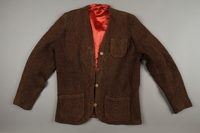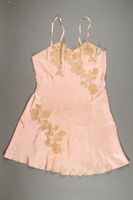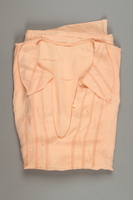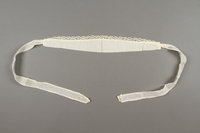Overview
- Description
- The Brust family papers document the wartime and post-war experiences of Elek Brust, Livia Brust, and their daughter Eva Brust in Hungary and later the United States. The papers contain correspondence, identification and immigration papers, restitution paperwork, family photographs, and Eva’s poesie book / autograph book.
Biographical materials include identification documents, immigration documents and restitution paperwork. Items of note include two membership identification cards for the Dohány-utcai templomi (Dohany Street temple), 1935; identification papers for Elek Brust, 1941-1944; copy of death certificate for Szereu (Serena) Schwarcz, 1942; three Schutz-passes for the Brust family initiated by Raoul Wllenberg, August 24, 1994; two certificates issued by the Swedish embassy exempting Lilly and Eva Brust from wearing the yellow star, August 24, 1944; a transfer ticket for Elek and Eva Brust, 1944; a certificate of release for Elek Brust, September 22, 1944; reissued birth certificates for Elek Brust and Eva Brust, 1946; applications for nonimmigrant visas for Elek, Livia, and Eva Brust, May 19, 1947; Elek Brust’s United States declaration of intention, May 2, 1952; naturalization certificate for Elek Brust, 1953; copy of two death certificates: Elek Brust, February 1, 1957, and Adolf Schwarcz, March 31, 1959; an inventory of Brust family household goods, undated; and restitution paperwork for the Brust family, 1961,1993-1994.
The correspondence series includes letters and postcards written in Hungarian by Elek Brust to his wife Livia Brust, 1933-1942; postcards; and letters relating to immigration, passports, and property in Hungary, 1946-1955. The financial materials series includes a bank deposit book, 1938-1944. A drawing of the Brust family bookplate is also include among the papers.
The printed materials series include a newspaper clipping; segments of three unknown songbooks, undated; the passenger list of the R.M.S. Mauretania, May 21, 1947; and the 82nd Congress, 1st Session H. Con. Res. 145 document dated July 26, 1951, which grants the status of permanent resident of the United States to the Brust family.
The Brust family photographs include photographs of the Elek, Livia, and Eva Brust in Hungary, as well as various unidentified friends and family members, 1914-1951, bulk dates circa 1930s-1940s. Images of the grave of Béla Brust, an unidentified grave yard, and a rubble filled street are also included.
Eva Brust’s poesie book, 1942-1946, includes entries from friends and family members including Elek Brust, Eva Brust, Terez Pimler, Penter Panczno, Istvan Vogel, Geza Fischer, Rozsi Fischer, Marta Deutsch, Oskar Deutsch, Istvan Deutsch, Gyula Falkai, Gloria Hidveghy, Eva Penres, Eva Szerres, Panni Deveny, Edit Veres, Judith Szilagyi, and Zsuzsa Urbach. - Date
-
inclusive:
1914-1955
- Credit Line
- United States Holocaust Memorial Museum Collection, Gift of Eva Brust Cooper
- Collection Creator
- Brust family
- Biography
-
Eva Brust Cooper was born on March 18, 1934, in Budapest, Hungary, the only child of Elek Brust (1899-1957) and Livia Lilly (Lilly, née Schwarcz, later Gach, 1912-2001). Elek was born on December 15, 1899, to Bela and Roza Orova Brust in Budapest, Hungary. Lilly was born on January 23, 1912, to Adolf (b. 1880) and Serena (née Deutsch, 1892-1942) Schwarcz, and had a younger brother, Laszlo (Leslie, 1919-1990.) Adolf had a prosperous watchmaking business, with a partner named Vogel. Both Eva’s grandparents and parents were university educated, upper class, and assimilated. Elek Brust and Lilly Schwarcz married on June 4, 1933. Elek owned a wholesale paper company and was a prominent member of the Jewish community. The family lived in a large apartment in Pest, with a chauffeur, cook, maid, and governess. They attended the Dohány Street Synagogue. Eva went to public school, where she received lessons in Judaism, and had tutors for English and French.
In spring 1939, Eva’s maternal grandparents visited the World’s Fair in America, and settled in New York, where they reestablished their watch business. In 1941, Eva’s father Elek was sent to a Hungarian forced labor camp. After several months, Lilly obtained his release using papers acquired on the black market. In August 1941, Eva’s maternal uncle Leslie left to join his parents in New York. In 1943, Elek Brust was again drafted into forced labor service, now under the control of the Hungarian Army. Lilly helped run the business while her husband was away and found ways to send Elek packages of warm clothing.
Sometime in March 1944, Elek was released from forced labor service. On March 18, 1944, Eva’s 10th birthday, German troops occupied Budapest. From their window the Brusts could see German soldiers marching through the streets. Afterwards, Jews were segregated and required to live in designated yellow star buildings. Elek used his connections to have their building declared a Jewish building, which allowed the Brusts to stay in their home. The Brust family lived in one room, while family friends lived in the other rooms. To assist the family, Eva and a friend would go outside and gather old cigarette stubs, repackage the tobacco, and sell them. Eva’s parents tried to shield her, but she heard the whispers and rumors and was aware of a growing sense of doom. She knew large trains of people were being sent to camps and witnessed trucks picking up people in the streets.
Eva and her mother attended a Catholic Church and completed the steps needed for conversion papers. On October 17, 1944, there was a coup by the fascist Arrow Cross Party. Eva’s parents obtained protective passes for the family from the Swedish consulate, initialed by Raoul Wallenberg. They left their home one night, taking no suitcases, but wearing multiple layers of clothes. Eva took her favorite pillow and her long braids were cut in case of lice. They stayed one night with Gentile friends and then moved around, hiding in various locations. They went to a Swedish safe house, but it was very crowded and her parents thought they would be safer elsewhere. They then went to an apartment building they had owned and stayed in the basement, and then in a vacant apartment. The building manager brought them food when he could. The city was under constant bombardment. By December 1944, Budapest was under siege by Soviet forces, and there was no electricity, gas, or water, and food was scarce. As the Red Army closed in, the family decided to get out of the city and walked to the countryside. Once, they were arrested and lined up with a group to be shot, but a bomb fell and the soldiers, either German or Russian, ran away. They stayed with a friend and then mainly on farms.
The family was in Érd, Hungary when Budapest was liberated by the Soviets on February 13, 1945. When they returned home many of their belongings had been stolen, but the building was livable. Elek restarted his business and Eva returned to school. Most of Lilly’s extended family perished, many killed in Auschwitz concentration camp. As Soviet control over Hungary tightened, they decided to leave Budapest and applied for visitor’s visas to the United States. On May 21, 1947, they left from England, travelling first class on the Cunard liner, Mauretania. When the family arrived in New York, Eva’s uncle Leslie met the boat. He had served in the US Army, landing in France during the D-Day invasion in June 1944. The Brust family settled in New York. Elek went to work in his father-in-law’s watch business. In 1955, Eva married Elihu Turgell and had a daughter in 1957. Eva worked as a teacher, and received a Master’s degree in special education. She later married Leslie Cooper. Her father, Elek Brust, died in 1957. Her mother Lilly, 89, now Lilly Gach after her 1983 remarriage, passed away in November 2001.
Physical Details
- Extent
-
1 box
- System of Arrangement
- The Brust family papers is arranged into seven series.
Series 1: Biographical materials, 1921-1994, undated
Series 2: Correspondence, 1933-1955
Series 3: Financial materials, 1938-1944
Series 4: Printed materials, 1947-1951, undated
Series 5: Artwork, 1942
Series 6: Photographs, 1914-1951
Series 7: Poesie book, 1942-1946
Rights & Restrictions
- Conditions on Access
- There are no known restrictions on access to this material.
- Conditions on Use
- The donor, source institution, or a third party has asserted copyright over some or all of these material(s). The Museum does not own the copyright for the material and does not have authority to authorize use. For permission, please contact the rights holder(s).
- Copyright Holder
- Ms. Eva B. Cooper
Keywords & Subjects
- Topical Term
- Children. Families. Holocaust survivors. Holocaust, Jewish (1939-1945) Jewish children. United States--Emigration and immigration. Wedding. World War, 1939-1945. World War, 1939-1945--Refugees. Budapest (Hungary)--History--Siege, 1945. Forced labor
- Geographic Name
- Budapest (Hungary) Hungary.
- Personal Name
- Brust, Béla. Brust, Elek, 1899-1957. Brust, Livia, 1912-2001. Cooper, Eva. Deutsch, Istvan. Deutsch, Marta. Deutsch, Oskar. Deveny, Panni. Falkai, Gyula. Fischer, Geza. Fischer, Rozsi. Hidveghy, Gloria. Panczno, Penter. Penres, Eva. Pimler, Terez. Schwarcz, Adolf. Schwarcz, Leslie. Schwarcz, Szereu, 1889-1942. Szerres, Eva. Szilagyi, Judith. Urbach, Zsuzsa. Veres, Edit. Vogel, Istvan.
Administrative Notes
- Holder of Originals
-
United States Holocaust Memorial Museum
- Legal Status
- Permanent Collection
- Provenance
- Eva Brust Cooper donated the Brust family papers to the United States Holocaust Memorial Museum in 2014 and 2018. The Brust family papers is comprised of two accessions, 2014.392.1 and 2018.409.1.
- Funding Note
- The accessibility of this collection was made possible by the generous donors to our crowdfunded Save Their Stories campaign.
The cataloging of this collection has been supported by a grant from the Conference on Jewish Material Claims Against Germany. - Special Collection
-
Save Their Stories
- Primary Number
- 1992.13.11
- Record last modified:
- 2024-04-11 13:19:05
- This page:
- https://collections.ushmm.org/search/catalog/irn699827
Additional Resources
Download & Licensing
- In Copyright
- Terms of Use
- This record is digitized but cannot be downloaded online.
In-Person Research
- Available for Research
- Plan a Research Visit
-
Request in Shapell Center Reading Room
Bowie, MD
Contact Us
Also in Brust family collection
The collection consists of clothing, documents, photographs, and portraits related to the experiences of Livia, Elek, and Eva Brust, their family, and the Vogel and Schwarcz families in Hungary and the United States, before, during, and after the Holocaust.
Date: 1914-1994

Knit cardigan with decorative buttons and lining owned by a Hungarian Jewish woman
Object
Knit cardigan with novelty buttons used by Livia Brust (later Lilly Brust Gach) during World War II (1939-1945) in Hungary. Livia was living in Budapest, Hungary, with her husband, Elek, and their daughter, Eva, when Hungary joined the German-led Axis Alliance in November 1940. Elek was a prominent member of the Jewish community in Budapest and a prosperous manufacturer. Beginning in late 1940, Jewish males were required to do forced labor service and Elek was sent to a labor camp. Livia managed the business while he was gone, and eventually obtained his release with black market papers. In 1943, Elek was conscripted again, and not released until March 1944. Later that month, German troops marched into Budapest. German authorities severely restricted Jewish life, and began deporting Hungarian Jews. In late August, Livia, Elek, and Eva obtained Swedish protective passes from Raoul Wallenberg. However, in October, they decided it was safer to go into hiding. They stayed in several places in the city, even as Soviet bombardment increased and there were power outages and food shortages. Eventually, they joined a family friend in the countryside. They hid in many places there, and were in the town of Érd when Budapest was liberated in February 1945. Most of Livia and Elek's family members perished. As Soviet control of postwar Hungary increased, the Brust family decided to leave. They sailed from England on May 27, 1947, and settled in New York City, where Livia's parents and brother had relocated in 1939 and 1941, respectively.

Pink chemise with corded, floral lace appliques owned by a Hungarian Jewish woman
Object
Chemise with corded lace appliques used by Livia Brust (later Lilly Brust Gach) during World War II (1939-1945) in Hungary. Livia was living in Budapest, Hungary, with her husband, Elek, and their daughter, Eva, when Hungary joined the German-led Axis Alliance in November 1940. Elek was a prominent member of the Jewish community in Budapest and a prosperous manufacturer. Beginning in late 1940, Jewish males were required to do forced labor service and Elek was sent to a labor camp. Livia managed the business while he was gone, and eventually obtained his release with black market papers. In 1943, Elek was conscripted again, and not released until March 1944. Later that month, German troops marched into Budapest. German authorities severely restricted Jewish life, and began deporting Hungarian Jews. In late August, Livia, Elek, and Eva obtained Swedish protective passes from Raoul Wallenberg. However, in October, they decided it was safer to go into hiding. They stayed in several places in the city, even as Soviet bombardment increased and there were power outages and food shortages. Eventually, they joined a family friend in the countryside. They hid in many places there, and were in the town of Érd when Budapest was liberated in February 1945. Most of Livia and Elek's family members perished. As Soviet control of postwar Hungary increased, the Brust family decided to leave. They sailed from England on May 27, 1947, and settled in New York City, where Livia's parents and brother had relocated in 1939 and 1941, respectively.

Peach nightgown decorated with embroidery owned by a Hungarian Jewish woman
Object
Nightgown with decorative embroidery used by Livia Brust (later Lilly Brust Gach) during World War II (1939-1945) in Hungary. Livia was living in Budapest, Hungary, with her husband, Elek, and their daughter, Eva, when Hungary joined the German-led Axis Alliance in November 1940. Elek was a prominent member of the Jewish community in Budapest and a prosperous manufacturer. Beginning in late 1940, Jewish males were required to do forced labor service and Elek was sent to a labor camp. Livia managed the business while he was gone, and eventually obtained his release with black market papers. In 1943, Elek was conscripted again, and not released until March 1944. Later that month, German troops marched into Budapest. German authorities severely restricted Jewish life, and began deporting Hungarian Jews. In late August, Livia, Elek, and Eva obtained Swedish protective passes from Raoul Wallenberg. However, in October, they decided it was safer to go into hiding. They stayed in several places in the city, even as Soviet bombardment increased and there were power outages and food shortages. Eventually, they joined a family friend in the countryside. They hid in many places there, and were in the town of Érd when Budapest was liberated in February 1945. Most of Livia and Elek's family members perished. As Soviet control of postwar Hungary increased, the Brust family decided to leave. They sailed from England on May 27, 1947, and settled in New York City, where Livia's parents and brother had relocated in 1939 and 1941, respectively.

Lace-trimmed headband or cap owned by a Hungarian chambermaid
Object
Uniform headband belonging to a maid employed by Livia Brust (later Lilly Brust Gach) before and during World War II (1939-1945) in Hungary. Livia was living in Budapest, Hungary, with her husband, Elek, and their daughter, Eva, when Hungary joined the German-led Axis Alliance in November 1940. Elek was a prominent member of the Jewish community in Budapest and a prosperous manufacturer. Beginning in late 1940, Jewish males were required to do forced labor service and Elek was sent to a labor camp. Livia managed the business while he was gone, and eventually obtained his release with black market papers. In 1943, Elek was conscripted again, and not released until March 1944. Later that month, German troops marched into Budapest. German authorities severely restricted Jewish life, and began deporting Hungarian Jews. In late August, Livia, Elek, and Eva obtained Swedish protective passes from Raoul Wallenberg. However, in October, they decided it was safer to go into hiding. They stayed in several places in the city, even as Soviet bombardment increased and there were power outages and food shortages. Eventually, they joined a family friend in the countryside. They hid in many places there, and were in the town of Érd when Budapest was liberated in February 1945. Most of Livia and Elek's family members perished. As Soviet control of postwar Hungary increased, the Brust family decided to leave. They sailed from England on May 27, 1947, and settled in New York City, where Livia's parents and brother had relocated in 1939 and 1941, respectively.
Portrait of a young Hungarian Jewish girl
Object
Portrait of a young Eva Brust painted in 1943. Eva was living in Budapest, Hungary, with her parents, Elek and Livia, when Hungary joined the German-led Axis Alliance in November 1940. Her father, Elek, was a prominent member of the Jewish community in Budapest and a prosperous manufacturer. Beginning in late 1940, Jewish males were required to do forced labor service and Elek was sent to a labor camp. Her mother, Livia, managed the business while he was gone, and eventually obtained his release with black market papers. In 1943, Elek was conscripted again, and not released until March 1944. Later that month, German troops marched into Budapest. German authorities severely restricted Jewish life, and began deporting Hungarian Jews. In late August, Livia, Elek, and Eva obtained Swedish protective passes from Raoul Wallenberg. However, in October, they decided it was safer to go into hiding. They stayed in several places in the city, even as Soviet bombardment increased and there were power outages and food shortages. Eventually, they joined a family friend in the countryside. They hid in many places there, and were in the town of Érd when Budapest was liberated in February 1945. Most of Eva's extended family members perished. As Soviet control of postwar Hungary increased, the Brust family decided to leave. They sailed from England on May 27, 1947, and settled in New York City, where Eva's maternal grandparents, Adolf and Szeren, and uncle, Laszlo, had relocated in 1939 and 1941, respectively.
Portrait of a Hungarian Jewish woman
Object
Portrait of Livia Brust painted in 1943. Livia was living in Budapest, Hungary, with her husband, Elek, and their daughter, Eva, when Hungary joined the German-led Axis Alliance in November 1940. Elek was a prominent member of the Jewish community in Budapest and a prosperous manufacturer. Beginning in late 1940, Jewish males were required to do forced labor service and Elek was sent to a labor camp. Livia managed the business while he was gone, and eventually obtained his release with black market papers. In 1943, Elek was conscripted again, and not released until March 1944. Later that month, German troops marched into Budapest. German authorities severely restricted Jewish life, and began deporting Hungarian Jews. In late August, Livia, Elek, and Eva obtained Swedish protective passes from Raoul Wallenberg. However, in October, they decided it was safer to go into hiding. They stayed in several places in the city, even as Soviet bombardment increased and there were power outages and food shortages. Eventually, they joined a family friend in the countryside. They hid in many places there, and were in the town of Érd when Budapest was liberated in February 1945. Most of Livia and Elek's family members perished. As Soviet control of postwar Hungary increased, the Brust family decided to leave. They sailed from England on May 27, 1947, and settled in New York City, where Livia's parents, Adolf and Szeren, and brother, Laszlo, had relocated in 1939 and 1941, respectively.
Portrait of a female Hungarian Jewish Émigré
Object
Portrait of Szeren Schwarcz painted in 1943. Szeren was living in New York City, in the United States, with her husband, Adolf, when Germany invaded Poland on September 1, 1939, and started World War II (1939-1945). Szeren and Adolf were originally from Budapest, Hungary, where they had raised two children, Livia and Laszlo, and Adolf had run a wholesale watch business. In 1934, the couple’s first grandchild, Eva, was born to Livia and her husband, Elek Brust. Starting in 1938, Hungary began passing anti-Jewish laws modeled after Germany’s 1935 Nuremberg laws. In April 1939, Szeren and Adolf visited the World’s Fair in the US. He was concerned about the aggressive actions being taken by Germany, and planned to settle in the US permanently. He did not tell Szeren because he knew that she never would have left. Adolf successfully reestablished his business in New York City. In June 1941, Hungary joined Germany’s attack on the Soviet Union. In August, Szeren and Adolf’s son, Laszlo, joined them in New York. On November 3, 1942, Szeren, died of cancer. German forces occupied Hungary on March 19, 1944. Livia’s family survived mass deportations by going into hiding in fall 1944. Soviet forces liberated Budapest on February 13, 1945. Most of Szeren and Adolf’s extended family members perished at concentration camps or were shot. In May 1947, Livia’s family immigrated to the US. They settled near Adolf, who gave Elek a job.
Portrait of a male Hungarian Jewish Émigré
Object
Portrait of Adolf Schwarcz painted in 1943. Adolf was living in New York City, in the United States, with his wife, Szeren, when Germany invaded Poland on September 1, 1939, and started World War II (1939-1945). Adolf and Szeren were originally from Budapest, Hungary, where they had raised two children, Livia and Laszlo, and Adolf had run a wholesale watch business. In 1934, the couple’s first grandchild, Eva, was born to Livia and her husband, Elek Brust. Starting in 1938, Hungary began passing anti-Jewish laws modeled after Germany’s 1935 Nuremberg laws. In April 1939, Adolf and Szeren visited the World’s Fair in the US. He was concerned about the aggressive actions being taken by Germany, and planned to settle in the US permanently. He did not tell Szeren because he knew that she never would have left. Adolf successfully reestablished his business in New York City. In June 1941, Hungary joined Germany’s attack on the Soviet Union. In August, Adolf and Szeren’s son, Laszlo, joined them in New York. On November 3, 1942, Szeren, died of cancer. German forces occupied Hungary on March 19, 1944. Livia’s family survived mass deportations by going into hiding in fall 1944.Soviet forces liberated Budapest on February 13, 1945. Most of Adolf and Szeren’s extended family members perished at concentration camps or were shot. In May 1947, Livia’s family immigrated to the US. They settled near Adolf, who gave Elek a job.



